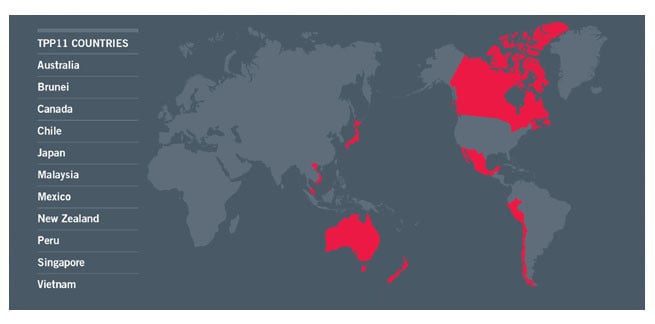Trade correspondent L.C. reports:

Congress and the Administration must get the partial government shutdown resolved if progress is to be made on pressing trade matters. The year 2018 not only brought the biggest yearly drop for US stocks since the 2008 financial crisis. The US global trade deficit also widened, as did the US trade deficit with China. US trade growth is expected to decelerate in 2019, as many orders were front-loaded last year to avoid coming tariffs. The IMF and WTO are warning of a trade slowdown. Foreign demand is weakening, led by China, whose festering economic problems threaten to infect the entire world economy.
US non-membership in the Trans-Pacific Partnership (TPP or CPTPP) is damaging US exports, especially agricultural exports. Today’s Wall Street Journal features an editorial similar to last week’s Founders Broadsheet on the subject. The Journal writes:
“The world turns even if America doesn’t. That’s certainly true on trade, where a rebranded Trans-Pacific Partnership has begun with the new year in 11 countries two years after President Trump withdrew. The biggest losers are American producers.
“The CPTPP, as it’s known, entered into force in Canada, Japan, Mexico, New Zealand, Australia and Singapore last week, where it will slash 95% of tariffs on goods among its members, which account for 13% of global GDP….
“[W]ithdrawal from TPP is a deadweight economic loss because it has led to no other trade concessions from anyone….The U.S. withdrawal from TPP was one of the worst own-goals in recent economic history. Mr. Trump isn’t likely to reconsider in the next two years, but perhaps the next President will.”
Trade agenda
Three issues top the US trade agenda for 2019. These are:
- Congressional action on the USMCA,
- The 90-day talks with China – the failure of which would mean more US tariffs imposed on China on March 2nd, and
- A decision on whether to impose Section 232 tariffs on international automotive imports.
Meanwhile, Section 232 steel and aluminum tariffs remain in place for almost all trading partners as US Trade Representatiave (USTR) Lighthizer negotiates to replace them with quotas. The metals tariffs are intensely disliked domestically by all but a few producers in the metals industry, because they raise prices and provoke foreign retaliation that hurts many sectors, led by agriculture.
An automotive Section 232 decision also looms. The Commerce Department’s report and recommendations were largely finished months ago and have been circulating within the Administration. Almost all of the President’s advisers reportedly warn against imposing these tariffs. They have no support within the US auto industry nor on Capitol Hill, but the President would like to slap on these tariffs anyway, and Commerce is expected to recommend that he do so.
This is an explosive matter. If he exempts those countries that expect to be exempted because they have or are negotiating trade deals with the US – Canada, Mexico, Japan, the EU, South Korea – then there is almost no vehicle-exporter left to hit. So a decision to impose these tariffs would mean that they would target at least some of the US’s closest allies, with an unknown impact on current talks or agreements.
The Section 232 and Section 301 tariffs imposed last year will have a continuing impact this year, as the Commerce Department and USTR, respectively, work through applications for product exclusions. The Commerce process has come under particular condemnation for being unfair, arbitrary, possibly even corrupt, and there will be efforts this year to review it and force it to be revised.
With China, if a deal is not reached by March 2nd, the President has said he will raise the 10% tariffs now imposed on $200 billion of imports to 25% and consider hitting the remaining $267 of imports from China with new tariffs, also under Section 301. China would retaliate against US businesses, using an array of means to punish them that go beyond retaliatory tariffs.
Meanwhile, Chinese dictator Xi Jinping, discomfited economically at home by the Trump tariffs and widespread foreign criticism of China’s trade and investment policies, is trying to divert domestic criticism by threatening an armed invasion of US ally Taiwan.
Curb the President’s trade powers?
Congress will decide this year whether to reassert its authority over trade policy. A number of bills were introduced last year to curtail the authority previous Congresses granted the president by statute. They didn’t get anywhere, but may be pursued this year, especially if the President alarms legislators with the imposition of Section 232 automotive tariffs or Section 301 tariffs encompassing all Chinese exports. Presumably, even protectionist Democrats would vote for a bill curbing President Trump’s power.
There is another possible development this year that could take away the President’s trade power – a decision by the US Court of International Trade (CIT) siding with the plaintiffs in their lawsuit claiming that Section 232 is unconstitutional. The American Institute for International Steel and two steel importers filed the case, which is now being heard and on which the CIT is expected to rule during 2019. Whichever side loses – the defendant (the government) or the plaintiffs – each has already announced it will appeal to the Supreme Court, so 2019 may not see the final resolution of the case.

Leave a Reply